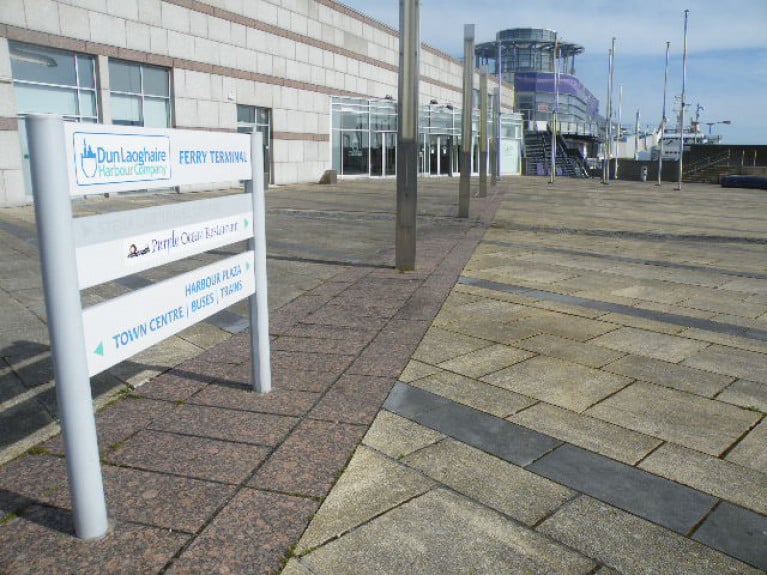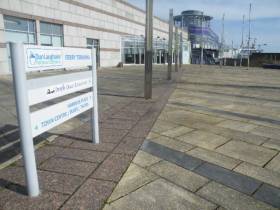Displaying items by tag: St Michael's Pier
New Ferry Terminal ‘Innovation Space’ Plans Could Create More Than 650 Jobs In Dun Laoghaire
More details have emerged of new plans for a technology hub at the site of the former Stena ferry terminal in Dun Laoghaire.
Lapetus Investments Ltd, trading as Quarterdeck Innovation, envisions a “co-working innovation space” within the St Michael’s Pier terminal building in Dun Laoghaire Harbour.
It intends “to create a technology hub whereby small and medium-size businesses can collaborate in a community-based environment that promotes and fosters entrepreneurship, through a spirit of innovation and creativity”.
The project team is led by accountant Hilary Haydon, a past president of Dun Laoghaire-Rathdown Chamber of Commerce and DLR Local Enterprise Office evaluation committee member.
And it’s hoped the scheme could create more than 650 jobs after five years in the south Dublin port town — which will pique the interest of the waterfront yacht clubs among many other local stakeholders.
 From Ferry terminal to state-of-the-art innovation campus - plans are in place to transform the old building Photo: Afloat
From Ferry terminal to state-of-the-art innovation campus - plans are in place to transform the old building Photo: Afloat
Key benefits touted by Quarterdeck Innovation include generating value of €10 million to Dun Laoghaire-Rathdown County Council over its first 10 years, as well as a local spend of €5 million annually.
And the project emphasises integration with its location, positioning the hub as particularly attractive for marine technology and research.
Lapetus/Quarterdeck intends to repurpose the building’s interior as a “state-of-the-art innovation campus” proposing “sensational sea views from almost every desk”.
In addition, its ground floor level would be a ‘Food Hall’ acting as a common area for co-workers to relax away from their desks, and which would also be open to the public as “an opportunity for strong local community interaction”.
The project partners have also pledged to “assist and collaborate closely” with the feasibility study team for the National Watersports Campus being proposed for Carlisle Pier to help “improve the harbour’s infrastructure resulting in improved access, job creation and strong tourism potential”.
Proposals to develop the former Stena ferry terminal were first made in 2017 but later scrapped over licensing issues.
Much more recently, the site has been suggested by a local senator as a base for a Covid-19 testing centre amid the current coronavirus pandemic.
Harbour Innovation Campus Plans For Dun Laoghaire Scrapped Due To Lack Of Foreshore Licence
Ambitious plans for a digital technology hub at the former Dun Laoghaire ferry terminal have been scrapped by its developer in the absence of the necessary foreshore licence.
As recently as August, the Harbour Innovation Campus project was moving forward after securing planning permission almost a year after the scheme was announced.
However, in an email to interested parties as seen by Afloat.ie this evening (Monday 29 October), developer Philip Gannon said that a year after signing the lease on the former terminal building, “the landlords have still not secured the foreshore licence necessary to allow them to legally lease the building to us.
“Needless to say I am appalled by this fact, given all of the time and trouble that I put into this project. I spent nine months finding a suitable fit-out team that were due to start in January.
“When I told them that work could not commence until a foreshore licence was granted, they told me they don’t do ‘stand-by’ and would be starting on another project in the new year instead.”
Citing uncertainty surrounding the foreshore licence, and the difficulties involved in putting together a new fit-out team, Gannon said: “I felt that I had no option but to terminate the lease and find an alternative property elsewhere.”
He added: “I deeply regret that in the end, I was unable to make this vision a reality in Dun Laoghaire.”
As previously reported on Afloat.ie, Gannon had been intending to invest €20 million in transforming the St Michael’s Pier building into the largest technology hub in Ireland, supporting up to 50 companies and as many as 1,000 jobs.
Dun Laoghaire Waterfront To Host ‘Ireland’s Largest Innovation Campus’
#DLHarbour - Reservations are now being taken for co-working spaces on Dun Laoghaire’s waterfront at what’s being touted as ‘Ireland’s largest innovation campus’.
As many as 1,000 workers will benefit from the facilities at the Harbour Innovation Campus at St Michael’s Pier, which is set to open in July next year.
Full time members can reserve a dedicated desk from €250 a month (€300 per member for a team space) with benefits including secure lockers, conference rooms and super-fast WiFi, as well as access to on-site mentors, start-up incubation, R&D labs, maker spaces and more.
More information is available in the campus’ online prospectus HERE.
Previously the former Stena HSS ferry terminal at St Michael’s Pier was made available to rent, following a partnership between the harbour company and online space-letting platform Fillit.
More recently, a “cluster of floating affordable homes” has been mooted for the adjacent Coal Harbour Dock, as reported last month on Afloat.ie.































































